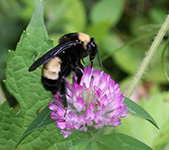Field Report from Sydney Cameron, University of Illinois Entomology Professor and expert on bee systematics and behavior

We hit gold last week with two bumble bee colonies! We were alerted to a colony in someone's back yard in Urbana, and went out to excavate it for a honey project. Expecting one of the common species (Bombus griseocollis, B. impatiens, B. bimaculatus, B. auricomus), lo and behold it turned out to be Bombus pensylvanicus (the American bumble bee), one of the species we have studied across eastern and midwestern North America and found to be highly threatened. Incredibly, we were alerted about a field colony in Sadorus and when we checked it the next day it, too, turned out to be B. pensylvanicus. Wow! We haven't seen this bee, except rarely, in years.
Historically, B. pensylvanicus had among the broadest geographic ranges of any bumble bee species in North America. However, in our current surveys B. pensylvanicus has not been observed across most of its historical northern and eastern range (estimated reduction approximately 23%) and is now abundant only in the south across the Gulf states and in the western portion of the Midwest.
If you look up details on the IUCN (International Union for Conservation of Nature), Red List for bumble bee species worldwide (I'm the Science Advisor for the Bumble Bee Specialist Group Steering Committee) you'll see that this species is highly vulnerable, and that conservation action is important, including restoring, protecting and creating natural habitat throughout its native range, along with other recommendations.
So the fact that 2 colonies have been found, one in Urbana and one in Sadorus, is fantastic news! It may be a fluke but it could suggest a possible beginning of a rebound in the population. We did not excavate either of these colonies for research because of their important conservation status. If either colony produces a large number of new queens at the end of the season, there is a chance that they will begin new colonies next spring and the population will grow.
This species is important, not only because it was one of the most widespread across the North American prairie, but also because this species is one of the most connected pollinator species in the region and its decline has affected ecosystem function. Therefore conservation actions are important.
B. pensylvanicus is as important as B. affinis – the rusty-patched bumble bee – because it has lost even more of its range than the rusty-patch. It is obviously still around, but its decline across such a large area makes it easily as great a loss. We are hoping to find more nests of this conservationally important species this summer, so we encourage our bee spotters to be on the lookout for more Bombus nests and to contact me if you find one!
Photos from the nest excavation:
